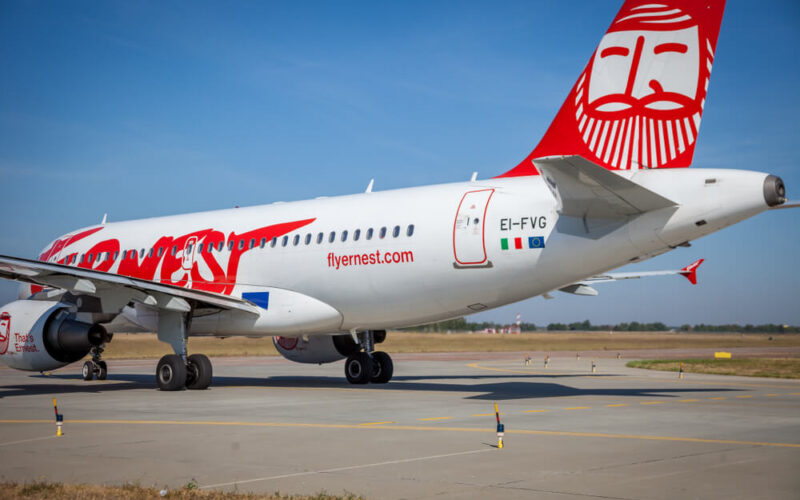The Italian carrier Ernest Airlines’ license was temporarily suspended as of midnight, January 13, 2020. The suspension comes after an initial warning by the Italian Civil Aviation Authority (ENAC) on December 29, 2019. ENAC said it would suspend Ernest Airlines’ Air Operators Certificate (AOC) if the airline fails did not submit the required documents according to European Union’s Regulation (EC) No 1008/2008.
Unfortunately, the suspension might have set off a chain of events that might lead to the eventual demise of the carrier even if ENAC restores the company’s license. According to a statement issued by Ernest Airlines, such an event is still a possibility if the Milan-based airline showcases that it fits all the requirements to possess the AOC.
“We have activated all the actions aimed at obtaining the revocation of the same provision, and we need time to provide all the necessary evidence as per Regulation (EC) n.1008 of 2008 to demonstrate our financial sustainability necessary for the resumption of our operations.”
Repossessed assets
Even before Ernest Airlines’ license was revoked, three out of four aircraft in the airline’s fleet were sent to storage. Namely, the affected aircraft were the triplet of A320s: EI-LIN, EI-LIX and EI-GCC.
Ernest Airlines stated that the notice issued by Italian authorities on December 29, 2019, “resulted in a series of events, which caused various blockages and difficulties to our operations,” possibly hinting that lessors were not willing to wait for the company to sort out its issues and risk their assets, namely the aforementioned aircraft.
All four of Ernest Airlines’ aircraft were leased from different leasing companies, according to planespotters.net data.
Pouncing competitors
However, the aviation industry never sleeps – just two days after the Italian carrier stopped its operations, some of its crucial routes are being overtaken by competing airlines. Looking at the destination map, the Italian airline operates most of its routes to the East, namely Albania and Ukraine, in addition to some domestic connections within its home country.
For example, Ernest Airlines flies 42% of the total capacity between Italy and Albania from various airports, including Milan-Malpensa (MXP), Milan-Bergamo (BGY), Bologna (BLQ).
The small-scale operator found a niche where it could stretch its muscles and try to hang onto a market where competition is fairly limited, yet there is enough demand. With a fairly sizeable Albanian (441,027) and Ukrainian (239,424) immigrant populations living in Italy, according to the Italian National Institute of Statistics, the demand for flights, especially low-cost, is definitely there. Ernest Airlines presented itself as a carrier with “low and competitive fares from low cost but not to the detriment of quality.”
Another low-cost carrier, that is also heavily present in the Eastern side of Europe, pounced on the capacity gap left by Ernest Airlines’ suspension of operations – Wizz Air. The Hungary-based carrier announced several routes from Albania on January 13, 2020: from Tirana, Albania (TIA) to Bologna, Milan, Pisa, Verona and Venice. All destinations were previously served by the paused Italian airline.
Dear Albanian and Italian travellers: we have great news for you! We’re launching 5 new routes between Albania and Italy. Fly from Tirana to Milan, Bologna, Verona, Venice or Pisa. Book your Dolce Vita holiday today at https://t.co/AeMNWOslh5! pic.twitter.com/YKoS4qxQaU
— Wizz Air (@wizzair) January 13, 2020
While currently there is no news on new flights from Ukraine to Italy to replicate the frequencies left empty by Ernest Airlines, Wizz Air could also be a perfect candidate to do so. Over the past few years, the purple LCC has been growing in the country, with the latest statistics provided by the airline indicating that it carried over 1.8 million passengers from and to Ukraine in the first nine months of 2019.
Route data indicates that measuring by capacity during the winter season, Wizz Air is the second-largest airline in Ukraine, with a market share of 10.8%. Ukraine International Airlines, the flag carrier of the country, is the number one with a share of 33.3%.
Nevertheless, Wizz Air’s only competition between Italy and Ukraine would be two ailing flag carriers Alitalia and Ukraine International Airlines. While the former is on the constant lookout for a new buyer and is currently in bankruptcy protection with numerous government loans, the latter posted a net loss of $100 million in 2018 and is forced to further cut costs. Thus, the opposition for Wizz Air would be shaky, at best.

